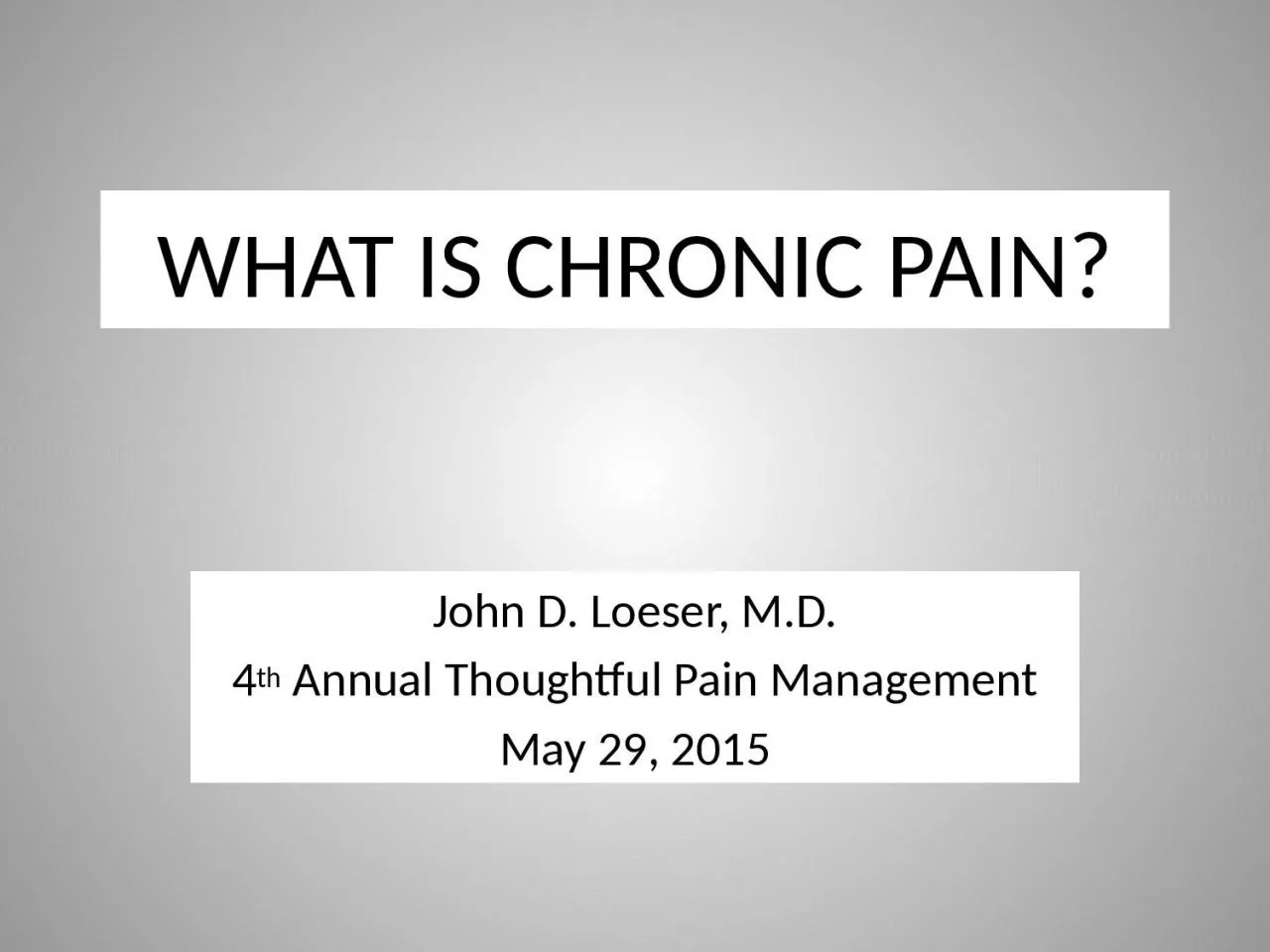

4 th Annual T houghtful Pain Management May 29 2015 PAIN IS AN UNPLEASANT SENSORY AND EMOTIONAL EXPERIENCE ASSOCIATED WITH ACTUAL OR POTENTIAL TISSUE DAMAGE OR DESCRIBED IN TERMS OF SUCH DAMAGE ID: 915424
Download Presentation The PPT/PDF document "WHAT IS CHRONIC PAIN? John D. Loeser, M...." is the property of its rightful owner. Permission is granted to download and print the materials on this web site for personal, non-commercial use only, and to display it on your personal computer provided you do not modify the materials and that you retain all copyright notices contained in the materials. By downloading content from our website, you accept the terms of this agreement.
Slide1
WHAT IS CHRONIC PAIN?
John D. Loeser, M.D.
4
th
Annual
T
houghtful Pain Management
May 29, 2015
Slide2PAIN IS AN UNPLEASANT SENSORY AND EMOTIONAL EXPERIENCE ASSOCIATED WITH ACTUAL OR POTENTIAL TISSUE DAMAGE OR DESCRIBED IN TERMS OF SUCH DAMAGE.
Pain, Suppl 3, 1986
Slide3ALL PAIN IS REAL.
MALINGERING IS A VERY RARE DISEASE.
Slide4TYPES OF PAIN
Slide5TYPES OF PAIN
Transient Pain
Acute Pain
Chronic Pain
Slide6TRANSIENT PAIN
Elicited by the activation of nociceptors in the absence of tissue damage. It is ubiquitous in everyday life and rarely a reason to seek health care. Relevant only to procedural pain, this is not a major issue in clinical medicine. It has, however, been the subject of most experimental pain paradigms in man and animals until very recently.
Slide7ACUTE PAIN
Elicited by injury to the body and activation of nociceptive transducers at site of damage.
Local injury alters the response characteristics of nociceptors, their central connections, and the autonomic nervous system in the region.
Healing of damaged tissue occurs with restoration of normal nociceptor function.
Common medical problem: health care blocks pain and facilitates healing.
Slide8CHRONIC PAIN
Triggered by injury or disease
Perpetuated by factors other than those that started the pain
Body unable to heal because of nerve injury or loss of body part
Stress, affective, and environmental factors likely to play a large role.
Slide9CHRONIC PAIN
Not well managed by Cartesian concepts.
Requires bio-psycho-social model.
May be induced by CNS changes in response to injury that are not reversible even though healing occurs.
Modulation can be detrimental or beneficial, hence role for psychological therapies.
Slide10TYPES OF CHRONIC PAIN
Associated with cancer
Associated with nerve injury
Associated with systemic illness
Unknown
causationPalliative care and chronic pain
Slide11PAIN IS MULTIDIMENSIONAL
No single measure adequately describes it.
It is a label for a group of observations.
There are components of pain such as site, intensity, duration, frequency, and qualities.
Slide12Anything you know that works for acute pain is likely to harm a patient with chronic pain. The only thing they have in common is the four letter word, pain.
Slide13TODAY WE KNOW THAT ACUTE PAIN IS A SYMPTOM; CHRONIC PAIN IS A DISEASE.
NOT ALL DOCTORS OR ADMINISTRATORS OF HEALTH PLANS UNDERSTAND THIS.
(AND A VERY EXPENSIVE ONE)
Slide14THE PUBLIC IS MISINFORMED ABOUT CHRONIC PAIN AND ITS TREATMENT BY PROVIDERS AND
BY DRUG AND DEVICE MANUFACTURERS, TO SAY NOTHING ABOUT THE LAY PRESS.
Slide15Doctors pour drugs, of which they know little, for diseases of which they know less, into patients—of which they know nothing.
Voltaire
Slide16RELIEF OF PAIN IS A PRIMARY REASON FOR HEALTH CARE
Slide17CONCEPTS ARE IMPORTANT FOR DIAGNOSIS AND TREATMENT
Slide18“All diseases of Christians are to be ascribed to demons”.
St. Augustine 354-430
Slide19ARISTOTELIAN
OR
CARTESIAN CONCEPT
Noxious
Stimulus
Pain
Slide20HARD-WIRED NERVOUS SYSTEM
Slide21HARD-WIRED NERVOUS SYSTEM
Slide22MODULATION OF SENSORY EXPERIENCES IS THE RULE, NOT THE EXCEPTION.
PERIPHERALLY GENERATED STIMULI PLAY UPON THE NEUROMATRIX, INFLUENCED BY EXPERIENCE AND ANTICIPATION, AND RESULT IN THE REPORT OF PAIN.
Slide23ONE CANNOT UNDERSTAND THE PAINS THAT BRING PATIENTS INTO DOCTORS’ OFFICES SOLELY ON THE BASIS OF ACTIVATION OF NOCICEPTIVE SENSORY ENDINGS OR UPON THE EFFECTS OF INJURY ON THE NERVOUS SYSTEM.
Slide24KROENKE
Slide25Nerves exist in a patient, who is, first and foremost, a human being and not just a biological machine.
Slide26Pain
requires
consciousness;
it is an emergent property of the human brain.
Slide27“NOTHING CAN PROPERLY BE CALLED ‘PAIN’ UNLESS IT CAN BE CONSCIOUSLY PERCEIVED AS SUCH”.
W
. K. Livingston 1998, p.207
Slide28“Pain is not just a stimulus that is transmitted over specific pathways but rather a complex perception, the nature of which depends not only on the intensity of the stimulus but on the situation in which it is experienced and, most importantly, on the affective or emotional state of the individual. Pain is to somatic stimulation as beauty is to a visual stimulus.
It is a very subjective experience.”
A. I. Basbaum 1987
Slide29Hurt and Harm Are
Not the Same.
Slide30CHRONIC PAIN IS NOT A STATE OF OPIOID DEFICIENCY.
Slide31OPIOIDS FOR CHRONIC PAIN?
Is there evidence for efficacy?
Are there side-effects?
Is addiction a potential outcome?
Can a patient be weaned off opioids?
Diversion is a major issue.Our focus should be on relieving the pain in our patient, not being part of a police state.
Slide32The health care provider should focus upon the patient’s functional status and quality of life, not upon the report of pain level.
Slide33Use your social reinforcement to reward wellness, not sickness behaviors. Ask the patient to tell you what he or she can do, not what they cannot do.
Slide34Non-specific treatment effects are often the difference between success and failure in the patient with chronic pain. Be sure that what you prescribe does not make the patient worse.
Slide35THANK YOU